Email Cascade for things you would like to see
here!
(anti spam address - use the correct @ protocol, please)
1.
Sand Change:
Periodically ( 5 to 7 years) your filter will require new sand. This task
will take 1 to 1-1/2 hours and can be accomplished with simple tools.
2.
Spider Gasket replacement:
The Spider Gasket (It LOOKS like a spider) is inside the MPV (Multiport
Valve) on you filter top. When the SG is worn, the pool leaks down the
backwash line. A 30 minute job that will save on water costs.
3. Change a pool light:
It's
a little tricky & fiddley, but you can do it like
a professional!. Allow
20 to 30 minutes for each light you need to change.
4. Service a Salt Chlorinator Cell:
Your
salt cell will need periodic acid washing. This is advanced stuff, and
involves handling Hydrochloric Acid, so be prepared! About a half hour
job.
5. Fixing the Aquagenie feeder tube.
On earlier models of the Aquagenie, the supply tube (water to the reservoir)
was easly displaced, often breaking the attachment point. Here is the
fix for this, and it will take less than 5 minutes.
6.
Patching a damaged pool liner.
In the unusual occurance of a hole in the liner, here is a simple way
to fit a patch, but you will need underwater equipment and be able to
hold your breath!
7. Clearing the Hair & Lint Strainer
(The clear top thingy on the pool pump) Occasionally this will block up with shed hair, leaves that pass through the skimmer basket and other fine gauge material. It must be removed for the pool pump to operate properly

This page is under development
Please bear with me as I add items as they are brought to my attention.
If you have an urgent need to ask for help, call Larry (021) 749 345
Procedures : Parts required for these procedures are available from AQUATECH 09 636 9921
Sand Change

1. SAND CHANGE:
FiIter Sand should be changed every five to seven years. The "sharp"
sand gets rounded off by the passage of dirty water, and must be replaced.
Before
starting this job, SUPERCHLORINATE THE POOL THROUGH THE SKIMMER so that
bacteria in the filter tank are neutralised. USE RUBBER GLOVES - Most
households have these disposable gloves for hand protection when manually
washing dishes. If you don't have any, go to your Supermarket & purchase
a box before you touch any filter sand.
Tools that will/may be required:
- 12" 300mm Stillson Wrench for undoing stubborn or overtight MAC
Unions,
12" 300mm Crescent Wrench for undoing Older Type filter top plate studs,
8" 200mm Cresent or Medium size Screwdriver for undoing Clamp Type filter tops,
Old tin can for scooping sand out, Bucket to contain scooped sand for disposal. Wet & Dry vacuum (if you have one handy) - Rubber Gloves for bacteria protection against cuts or abrasions from inside the tank
Materials required
- 4 to 5 bags sand(Check with Aquatech) 14/24 Filter Sand (0.4 & 0.9mm)
- Vaseline for lubricating "O" rings
- Masking Tape or cloth to make a bung to protect 40mm return tube in tank,
- O ring for MPV plate to filter tank seal
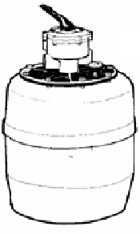
NOTE: Read ALL
OF THIS before commencing:
After removing the Top Plate with MPV you will see a 40mm PVC pipe sticking
up through the sand (and water). Put your GLOVES on BEFORE touching the
sand and water in the filter tank. Using yout tin can, empty the sand and water from the tank into your disposal
bucket, checking that the media you are removing IS filter sand and not
the bottom GRAVEL media. You will evacuate several bucket's full depending
on the filter size. Once you hit the GRAVEL at the bottom of the tank,
it is time to stop the emptying process, as the gravel does not normally
require replacement.
You may have a "Wet & Dry" vacuum unit which could assist
in this process. Check that your unit is suited for this task before sucking
any water through it.
Use the cloth or tape to protect the 40mm upstanding pipe (which should
be held in position by the remaining gravel in the tank) so that the new
sand media does not go down it to the wrong side of the bottom septum
(which is the collection point for the filtered water to be returned up
this tube and back to the pool)
Gradually tip or scoop the new sand media into the filter tank and spread evenly around the upstand pipe with your hands. USE GLOVES to avoid abrasions and possible infection. Sand should fill to approximately 150mm from the top. When all the sand is installed, gently refit the Top Plate, ensuring that the receptor aperture on the underside of the Top Plate fits neatly over the 40mm upstand, as this is when the filtered water re-enters the MPV to be diverted back to the pool. Also bear in mind the ORIGINAL POSITION of the MPV outlets, as they must line up exactly with the existing plumbing. This is not so hard with a bolted on top - as they will line up only one way - but more difficult if a clamp system has been used, where it's better to leave it loosened until the plumbing is re-connected, THEN tighten the circular clamp.
Once all is re-connected, turn the MPV handle to BACKWASH, then start the pool pump. Backwash the filter for at least TWO MINUTES to remove all loose dust and debris that may have been included with the media. Check the pressure gauge, and note the new reading: this will be your new starting point for backwashing when it increases by 7psi or 1/2 Kilopascal.
NOTE: New filter media that is superior in filtration to 14/24 sand is available from FILTERMASTER for a crisper, cleaner water look and longer backwashing cycles. Call Steve Budden 09 448 2135 or details.
Spider
Gasket
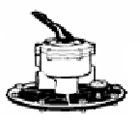
2.
Spider Gasket:
The
Spider Gasket usually lasts from 5 to 7 years, and when it starts failing,
you will notice a "pool leak" i.e. the pool water will start
to drop. Discounting other causes of leaks, the spider gasket keeps pool
water passing through the MPV from diverting off into the backwash line.
Check your backwash line while the filter is operating, and if you see
a drip-drip-drip you can assume that the Spider Gasket is either compromised
by a speck of debris (stopping the seal) or has perished and needs to
be replaced. FIrst try a couple of flush-outs by truning the MPV handle
to WASTE or RINSE and switching the pump back on, then off afcter 10 seconds,
then on again. Several times will flush any debris that could be stopping
the valve from sealing properly on the MPV, thus causing a leak.
Tools that will/may
be required:
- Medium size PHILLIPS
HEAD Screwdriver for undoing top screws,
- Small paint scraper (the smaller the better - 1/2 inch preferred)
Materials required
- Contact Cement "Gorilla Grip" or similar
- Vaseline for lubricating "O" rings
- Spider
Gasket replacement
- O
ring for MPV seal
Using the medium size Phillips Head screwdriver, undo the screws holding the top of the multi-port valve in position. Carefully extract the tio unit which comprises the Head (with port-change handle) and Body.
Look into the cavity exposed, and you will see a gasket called the Spider Gasket (you will see why it's called that, by the shape). This is generally glued in position at the factory, and may be destroyed in the process of removal. If possible, you will have already obtained a replacement by ordering it from us, but if not, try to keep the old gasket intact so you can take it to a pool shop (or Cascade) for a replacement.
Using the scraper, gently remove all vestiges of remaining gasket and/or adhesive until the surface is flat and clean. DON'T DAMAGE the surface, or the valve will leak at this point, as the water is under quite high pressure as it passes through.
Spread the contact glue sparingly over the flat surface, the GENTLY position the new spider valve in the CORRECT POSITION. You may want to test first without the glus, and put a pencil mark or twink dot on the gasket and the valve body so you can line them up when the glue is in place.
Align the valve top correctly and replace the screws, using opposite screws for the final tightening (i.e. 12 - 6, 2 - 7, 3 - 9, 4, 10 etc) DON'T OVERTIGHTEN!
Place the MPV Handle on the BACKWASH position, and re-start the filter. After a few seconds, switch off, turn the handle to FILTER and switch on again. Check the BACKWASH sight glass to ensure no water is passing through.
That's it!
Pool lights

Tools that will/may
be required:
- Stubby
Wide Blade flat head screwdriver
- Medium size Screwdriver for undoing screws
Materials required
- Waterproof Silicone Sealant
- Vaseline for lubricating "O" ring
- "O" ring for light seal
- Replacement QH 100 or 150 watt headlight style lamp
- Replacement
QH bulb (touch sensitive)
Procedure
NOTE: This procedure applies to the 100w PoolQuip type pool lights commonly used in all Cascade pools. It does not apply to L.E.D. lights. Before proceeding, ensure that the power to the light has been shut off.
PoolQuip lights are contained within a niche that protrudes through the pool wall.
The light fitting is held in the niche by two small toggle restraints. these are opposite each other on the outer bezel of the light fitting. using a flat-head screwdriver, rotate each toggle 45o counterclockwise. This will release the light fitting and allow it to be brought up to the pool deck level. (There should be ample cable to do this)
The back side of the light fitting has a series of screws that - when removed - allow the two halves of the fitting to be split apart. When this is done, the bulb/reflector component can be disconnected from the powerwire.
Remember the order in which the unit is seperated - you have to re-assembe in the reverse order to disassembly! The wire must go through the outer half as before.
Replace the defective light with the replacement unit. Usually this is a one-piece integrated unit. If your light has a "bulb" that can be removed, you only need a replacement bulb, but these types were discontinued quite a few years ago, and seperate bulbs may not be available.
Reconnect the wires to the light/bulb and encase generaously with waterproof silicone gel.
Clean the groove the the "O" ring came out of, clean the "O" ring carefully, and add some Vaseline to aid in sealing the two halves - as they must be waterproof.
When you are satisfied that the "O" ring is seated correctly, start replacing the screws loosely back. Don't tighten them yet.
When all the screws are in place, gently & slowly in turn tighten them slightly in a 1-3-5-7 rotation because the two halves must accuratety fit with equal tension on the screws to ensure a tight and equal fit. If you fail to do this correctly, the first time you switch the light on the heat from the bulb will expell the trapped air unless the "O" ring is a perfect fit and contains the air pressure. (If this happens, when the light is turned off, the partial vacuum in the light fitting will suck the pool water in and short-circuit the light - so be absolutely sure you have done the procedure correctly)
Re coil up the wire, and replace the light fitting into the nich - ensuring that the lens is correctly aligned in a horizontal mode. (rotate the fitting until it looks correctly lined up) then rotate the toggles back 45o clockwise to restrain the light in the niche.
Test the light for function. Does it light up?
Congratulations, you have replaced a pool light!
Salt Chlorinators
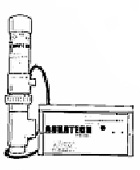
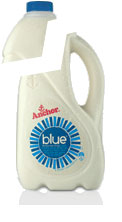
Cut milk container as shown to produce suitable soak container
4. Service a Salt Chlorinator Cell
Take care - you are handling Hydrochloric Acid!
Wear the recommended safety equipment!
1. After powering down the system and unpluging the saline generator, remove the saline electrode (in the clear glass tube) by unscrewing the large MAC Union nut on one end of the housing. You may need to use the Stilson Wrench if it is tight (but not when replaceing it - just a firm hand-tightening should suffice. Check for leaks when started up.)
2. Add water to Soak container - 3/4 full
3. Carefully add approx 150 ml (two cupfulls) of Hydrochloric Acid to the water. Recap the Hydrochloric Acid immediately! ADD WATER FIRST to avoid wave spillage if Acid is placed in first!
4. Place the electrode - plate end first - into the Soak container - the acid/water should cover all of the electrode's plates. Fizzing will instantly occur as the buildup of calcium contaminant is burned off
5. After the fizzing has ceased, remove the electrode from the mix and carefully hose down with clean water. There should be no calcium buildup left on the electrode plates at this point iof you have left the electrode soaking for long enough.
6. Replace the electrode into the fixed clear glass housing and tighten the crox nut. Do not overtighten! Power up the pool system first and when satisfied all is well, switch on the Saline Generator. Check for leaks.
7. Dispose of the remaining acid/water mix properly (OSH tell us to put used mixture into a glass container and take to a disposal point - if you can find one near you) Remember - it is still a potent ACID mix that can harm you or damage your clothes.
- Don't tip it down the septic sewer or stormwater drains - it's a Council by law
- Don't tip it on the garden - It's a resource issue about changing the pH of the soil, which is illegal under the Resource Management Act.
- It is a useful solvent for cleaning stains on concrete, but treat respectfully as it's ACID
- You may have to use your imagination regarding disposal of the waste
Tools that will/may
be required:
- 12" 300mm
Stillson Wrench for undoing stubborn or overtight MAC Unions,
- Bucket to contain used acid for disposal.
- Suitable Soak container for cleaning process (a 2 liter PVC Milk container can be modified to leave the handle on, which is very desirable when carrying acid in any container)
- Rubber Gloves for acid protection
- Safety glasses or goggles for eye protection
- Gumboots to protect feet & lower legs against acid burns
Materials required
- Hydrochloric Acid from Pool Shop
- Glass disposal vessel for used HydroChloric Acid
- Paper & Tape
to wrap glass vessel
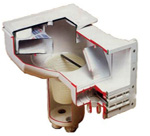
5. Fixing the Aquagenie feeder tube
Call Aquatech (09) 636 9921 for the parts required
Older model Aquqgenies skimmers were susceptible to catching the flexible water tube and potentially snapping off the connection point into the lower body as the tube was often supplied "too long". When the skimmer basket is being removed to empty it can break the connector piece off. This has been eliminated in post 2010 model Aquagenies
If this happens in your skimmmer but the connector has not broiken off yet, there is a fix available to hold the tube out of the way.
Aquatech will supply a PVC part that glues inside the skimmer body to hold the flexible tube out of the way, thus eliminating the chance of breaking the connector off. Here is the procedure:
1. Lower the pool water down sufficiently to allow you to work inside the Aquagenie body and access the feeder tube connector point.
2. Hold the PVC block and tube together, and using the soft-lead pencil mark where the PVC block is to be glued.
3. Thoroghly dry this area with the paper towels
4. Fit the tube into the PVC block, and apply solvent to both the block and the location area. Wait until the solvent becomes tacky, then press the block onto the skimmer wall. USe the Silver Tape to hold the block in position until the solvent joints the two together
Tools that will or may
be required:
- 2HB soft lead pencil or similar for marking the inside of the skimmer
- Two sheets of kitchen type parer towels
- One sheet of fine grade wet & dry sanding paper
- 1 x roll of Danco Silver Tape
- PVC type solvent glue
- 3 mm diameter drill bit
- Hand drill or battery operated drill (don't use 240v mains drill near the pool water)
Patch
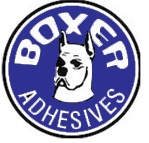
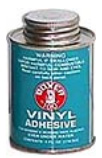
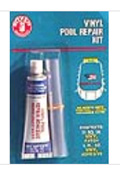
6. Patching a damaged pool liner
BOXER brand underwater adhesive is available from Aquatech (098) 636 9921
Procedure:
Clean the liner area that needs the patch as best you can (don't use any cleaning product).
Ascertain the size of the patch required and using a round object (coin, jar lid etc) cut a circular patch the will more than cover the damaged liner. Roughen up the "back side" - the "shiny" side using the wet & dry sandpaper. (Note - there is a back and front side of the liner material) This will assist stickability!
Using the sandpaper taper the edge of the patch off around its perimeter so it reduces the edge thickness from the top down and assists it not being caught on the vacuum brush and pulled off the liner.
Apply the underwater glue to the back side of the patch, and place it nearby the liner where it will be needed soon.
Go to where the patch is needed, and using the sandpaper, roughen up the vinyl where the patch is intended to go. Apply the underwater glue using the brush supplied (tin) or the tube nozzel if using a tube. Get the patch that you have prepared and place it firmly onto the glued area you have just prepared.
Hold down on the patch for as long as you can (if you are underwater and holding your breath) Place the sandbag if possible to hold the patch down.
This is not easy of the patch is on the wall or sloping floor, so just ensure that the patch is holding the best you can.
Don't vacuum the pool for 24 hours, When you do vacuum the pool, take special care when vacuuming in the vicinity of the patch. Eventually it will bond and be as good as the liner itself.
TIPS:
* Use circular patches if possible
* The patching material supplied with the tube is not as good as using liner material.
* If you have to use a square or rectange patch, cut a radius at the corners. This will help it survive a pool vacuum that might pick up a corner
* Try to champfer the top egde of the patch down to eliminate a sharp edge that might be caught by a vac brush
Tools that will/may
be required:
- Spare liner material (the same color as your pool - if you don't havew any, call Aquatech for assistance)
- Wet & Dry fine sandpaper
- BOXER brand underwater adhesive ,
- Underwater Goggles (If the repair is under water)
- Sharp scissors
- Medium size Kitchen Bag filled with sand
HAIR & LINT STRAINER
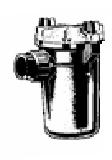
7. Clearing the Hair & Lint Strainer basket
1. Turn off the pool pump and OZONE unit where fitted.
2. If there is a three-way valve fitted in front of the pump, turn it to the CLOSED posiiton
3. Loosen the clear lid of the hair and lint strainer. Often these get very tight, so some tool may be required, but BE GENTLE as it is plastic and can break!
4. Remove the clear lid by unscrewing in an anti-clockwise direction and pull the white basket gently out of the hair & lint strainer body.
5. Remove all debris from the basket. Give it a tap on something solid to dislodge any small particles that might have lodged in the plastic mesh.
6. Replace the basket GENTLY taking into consideration that some of them fit only ONE WAY (often there is a 50mm gap where the pool water enters the basket) and when in place DO NOT ROTATE the basket, as this can break off positioning lugs that can be sucked into (and damage) the pump impellor.
7. Re-prime the pump by filling the Hair & Lint Strainer body with water from the bucket. Don't worry if it starts to drain back to the pool (if there is NO valve fitted) but be as quick as you can in replacing the clear lid to maintain a good water level in the body. More air in there = more time to prime up the pump!
8. The clear lid has a groove under the clear top. This groove holds an "O" ring which is usually a press fit. Often when they get older, the O rings fall out of the groove. Sometimes they partially come out of the groove, then get distorted when the lid is screwed back on. THE PUMP WILL NOT PRIME if this O ring is not securely in place! If it won't stay in the grove when you turn the lid up the other way to replace it, try a little Vaseline or a similar viscose substance to hold it in place.
9. Turn the three-way valve handle to the OPEN position. When all is well, switch the pool pump on. It might take ten minutes to dispell all the air trapped under the lid, but eventually it will all dissapear. Remember - the more full it is to start with, the sooner the pump will prime!
10. Check the pool return nozzle (or Aquagenie slot) to ensure the water is returning normally to the pool
11. Turn the OZONE unit back on.
That's it!
Tools that will/may
be required:
- Bucket to re-fill strainer pot with pool water (or garden hose)
- Something to tip the leaves etc. into for disposal
- Vaseline or similar viscosity silicon based gel